Everyone on the internet tells you that building a Shopify store is easy.
And while a Shopify store is a great online business venture, becoming successful is not always as straightforward as people would have you believe.
As with any business, there’s a lot to consider. There are many challenges to overcome and lots of unforeseen issues to tackle.
That’s where Shopify tips come in.
In this post we've curated 14 actionable Shopify tips that will steer you clear of common pitfalls and set you on the express lane to profitability.
From finding winning business ideas to optimizing your store for maximum sales, this guide has you covered.
So, let's dive in and unlock the secrets to building, launching, and scaling your thriving online business!
4 Shopify Tips to Find Winning Business Ideas
Here’s the truth: most Shopify stores fail because they do one of the following things:
- Try to sell a product with little to no demand
- Don’t have a way to reach people who want their products
So hands–down the two best Shopify tips we can give are:
- Find a product people want
- Find a way to reach the people who want it
It seems simple. Possibly even too simple. But selling a product with validated demand, to a validated audience is the key to profitability.
See, lots of budding entrepreneurs think that you have to reinvent the wheel. You know, come up with a brand new product that the world is waiting for.
But in reality, all you need for ecommerce success is to be an effective middleman.
So, flip the traditional process on its head – replace brainstorming brand new product ideas, with looking for market trends. Then simply step–in and give the people what they want.
Seriously, when you find something that’s popular and get it in front of the people who want it, making sales is so much easier – even if the rest of your strategy is sub–optimal.
Here’s how you can do this:
Find What’s Already Popular
Sticking with the theme of ‘not reinventing the wheel’ one of the best ways to get product ideas is to look at what’s already popular.
Amazon Bestsellers & eBay Watchcount are two places where you can discover products that are selling well. For example, after a quick scan of Amazon’s bestsellers, I found these two hooded blankets in the Fitness category:
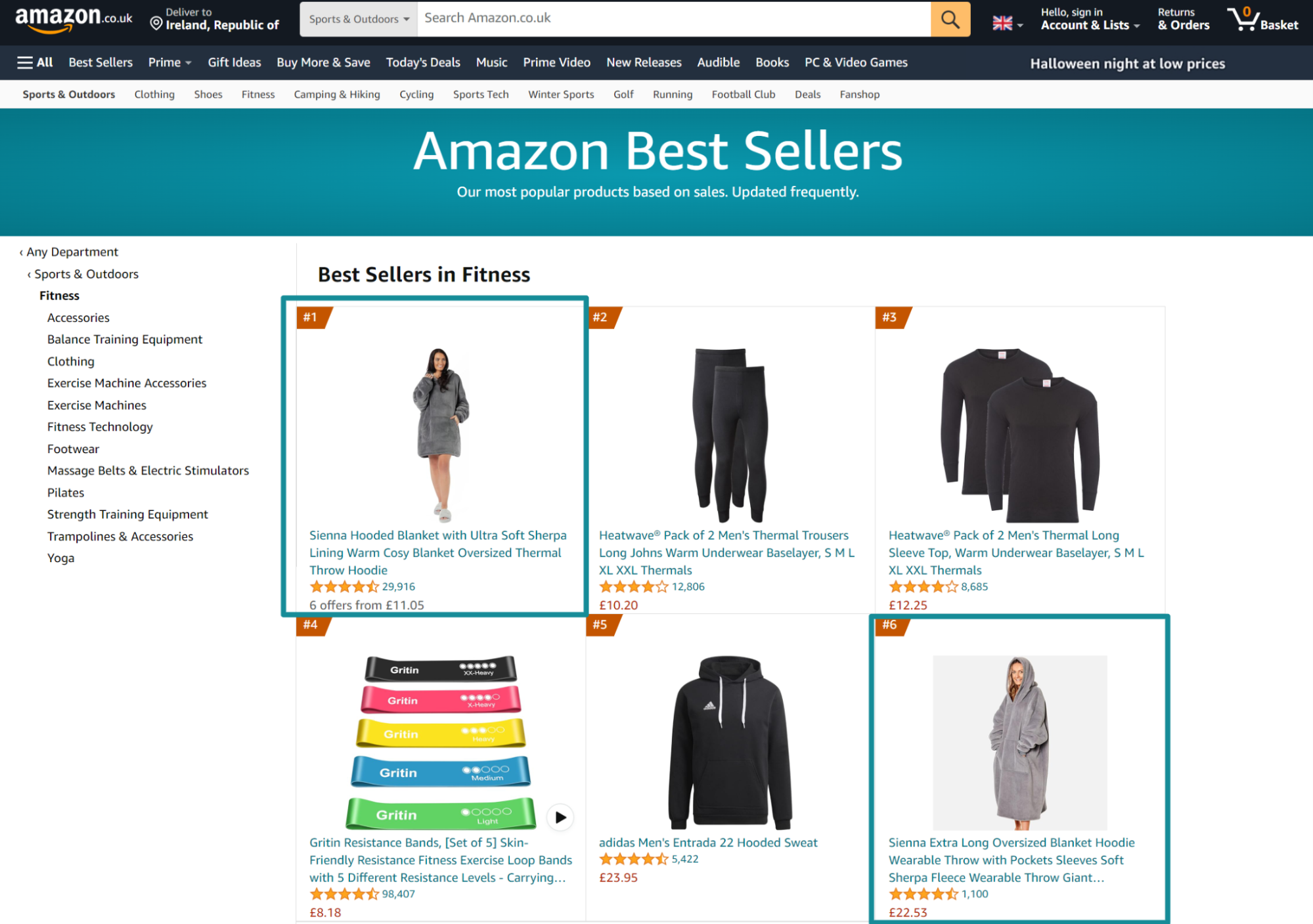
Use Data To Validate Consumer Trends
Once you’ve created a list of products that are in demand, you can further validate them by looking at search trends. This allows you to assess if a product (or niche) is increasing or decreasing in popularity.
Below you can see that search demand for the product we identified above –‘hooded blanket' is increasing steadily since 2016. This particular product is seasonal – hence the peaks and troughs around Christmas time. This is a good proxy for suggesting that consumer demand is also increasing.
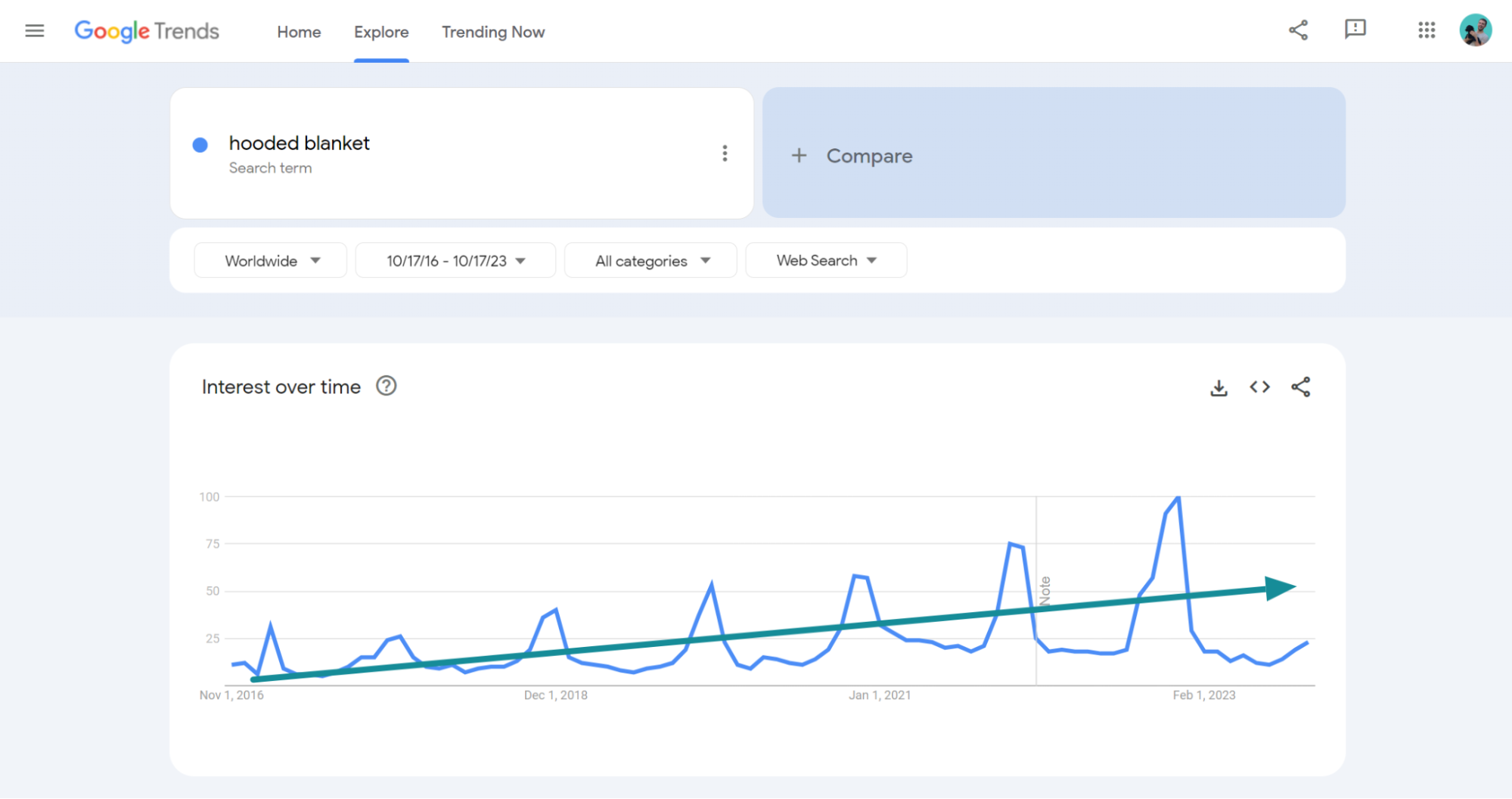
Look At What Others Are Selling
Next, you can explore if anyone else is selling this product effectively. With some quick research on the TikTok Ads library, I found a brand called ‘The Oodie’ that’s killing it with viral content. In the comments, you can see their audience are saying things like ‘we need this’ and ‘me and my bestie neeeeeed’ which shows strong purchase intent.
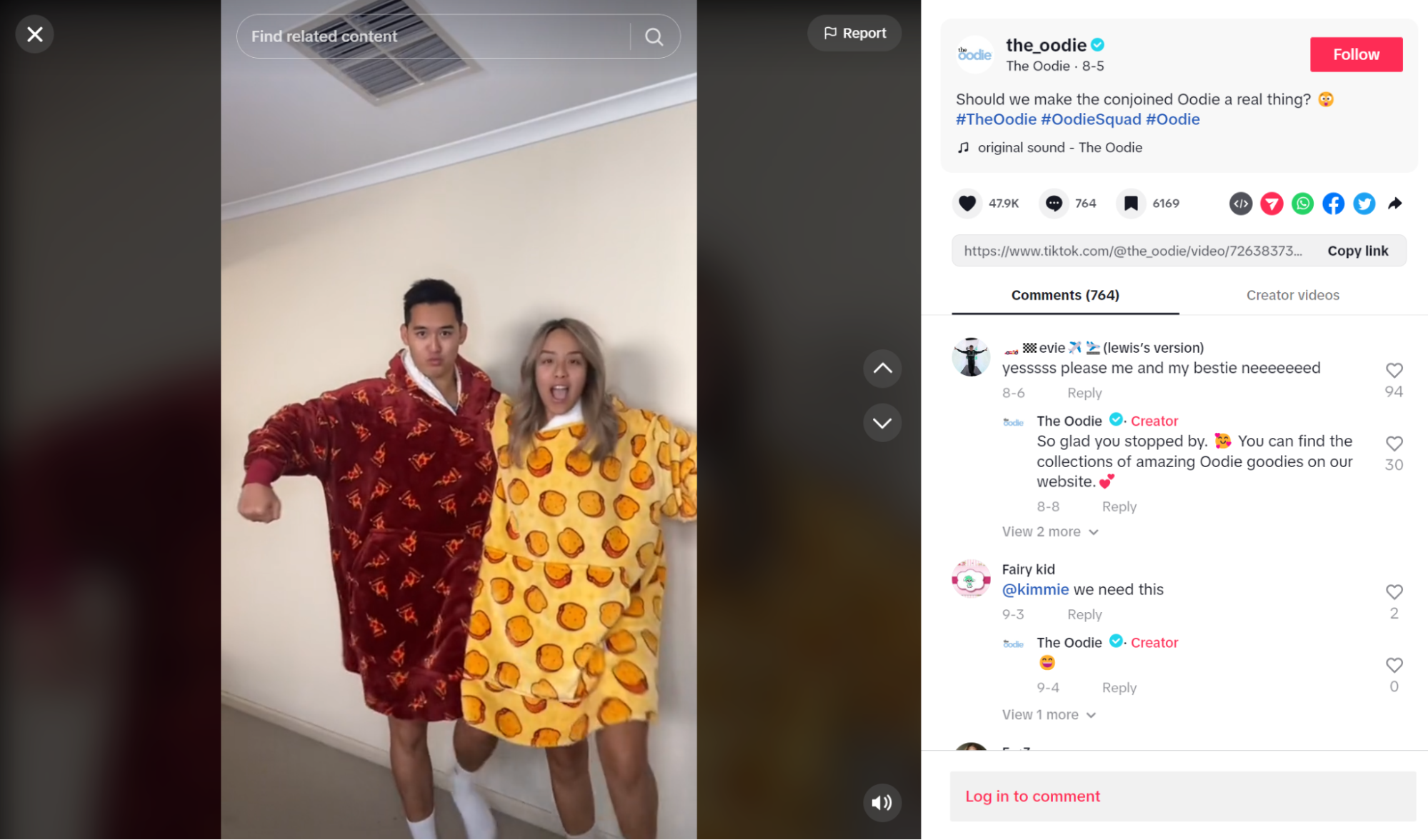
Figure Out How You’ll Reach Your Customers
Now that you’ve created a list of validated products to sell, it’s time to think about how you’ll get them in front of your audience.
This matters because not all products can be marketed in the same way. For example, let’s suppose you find that commercial pizza ovens are trending.
Trying to market your ovens over TikTok probably won’t yield the best results. You’d likely be better off putting ads in an industry magazine or attending restaurant trade shows, right?
So, first develop a basic buyer persona. If you’re just starting, you don’t have to go into massive detail here – you can develop a more complete persona down the line. For now, we just need a minimum viable persona.
Hop over to Hubspot's free persona generator and build a quick picture of your ideal customer. It’s important to understand things such as:
- Where do they start looking for products (e.g. Google search or Instagram scrolling?)
- The things they care about (e.g. sustainability, convenience, family, social status etc)
- The language they use (e.g. Gen–z slang or formal speech?)
- Basic characteristics such as age, income, and the problems they face
Once you’ve built a picture of your customers, you can create a much sharper marketing strategy. You can decide the best way to reach and communicate with them in a meaningful way.
3 Shopify Tips for Setting Up Your Store
Okay, now that you’ve found a winning product, and an audience to sell to, it’s time to build out your storefront. The first step is to choose the right Shopify plan for your needs.
Choose The Right Shopify Plan
When you first launch your store, you’ll have to select a Shopify plan. Shopify’s has three main plans that’ll suit most newcomers needs:
- Basic ($29/mo)
- Shopify ($79/mo)
- Advanced ($299/mo)
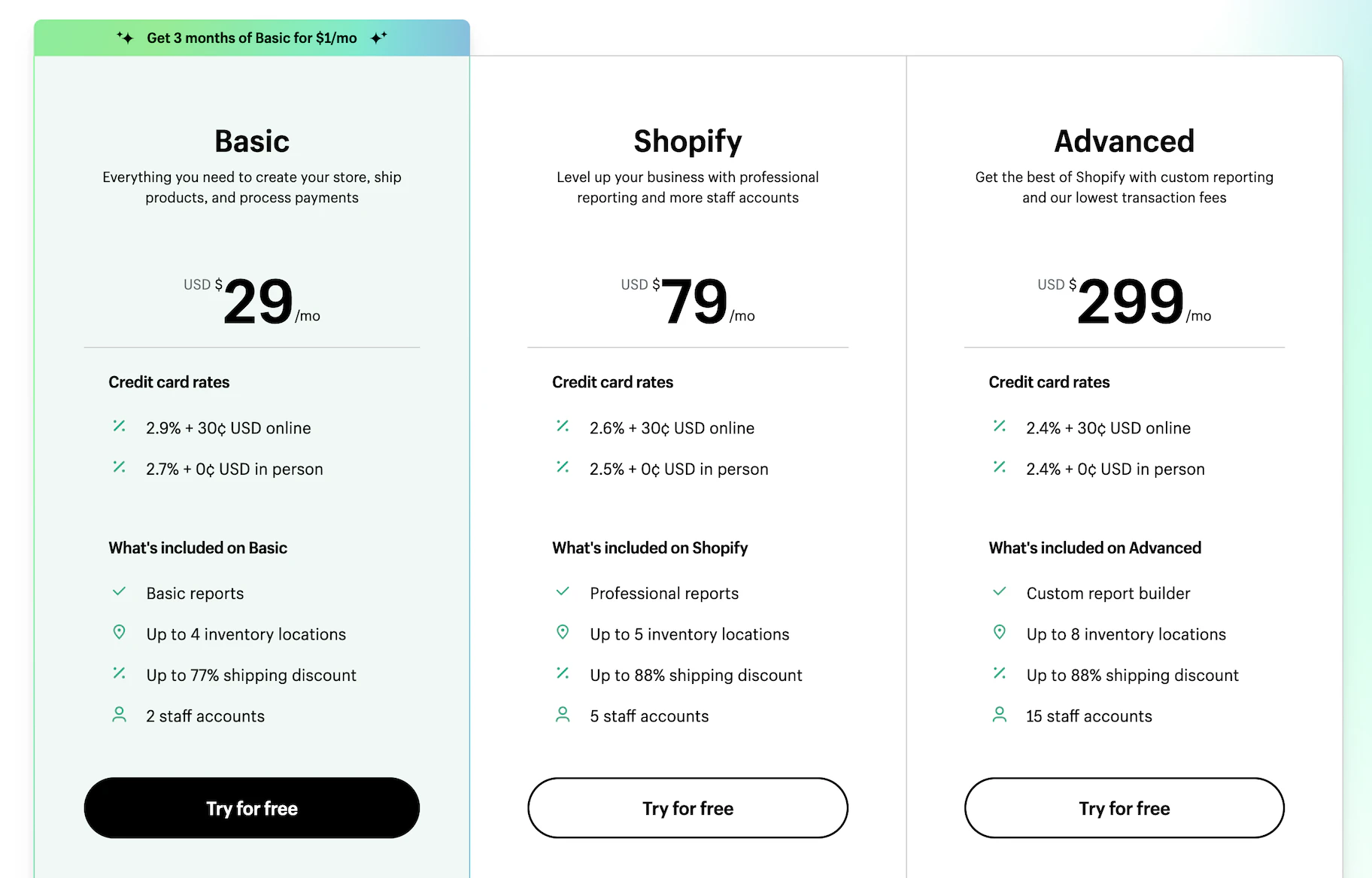 If you’re just starting out, the basic plan includes pretty much everything you’ll need to get your store off the ground.
If you’re just starting out, the basic plan includes pretty much everything you’ll need to get your store off the ground.
On the customer–facing end, all the plans look identical – so there’s no need to worry about looking less professional with a more basic plan. With more advanced plans you’ll get things like access to better analytics, lower transaction fees, and more staff accounts.
After you’re making sales, it may make more sense to upgrade your plan – but for now, just select the basic plan to get going.
Select The Best Shopify Domain Name
Selecting the ideal domain is a big step in establishing your online presence.
Much like choosing a storefront for a physical shop, your domain is the digital face of your brand. If you haven’t thought about branding at all Namelix is a useful tool that you can use to generate workable ideas.
Here’s some examples I generated in about thirty seconds for a hooded blanket business:
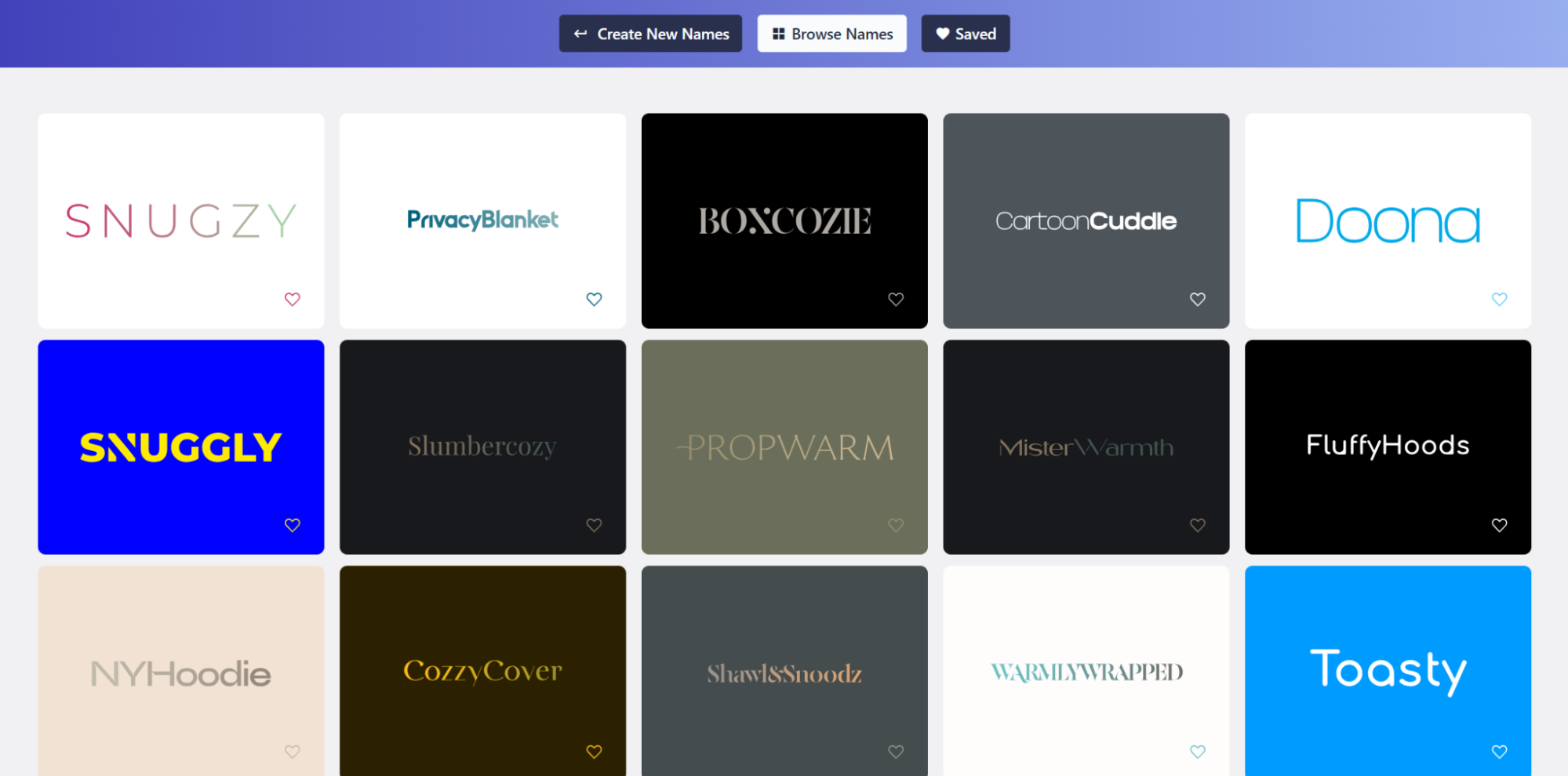 When choosing your domain, opt for simplicity and memorability; a short, easy-to-recall name is gold. Steer clear of complex spellings or obscure words. Your domain should flow effortlessly, like a familiar tune.
When choosing your domain, opt for simplicity and memorability; a short, easy-to-recall name is gold. Steer clear of complex spellings or obscure words. Your domain should flow effortlessly, like a familiar tune.
Furthermore, ensure it mirrors your brand and purpose. If you're a hooded blanket brand, a domain like "Snuggly.com" paints a clear picture.
Stick to trustworthy extensions like the timeless(dot)com, although alternatives like .net, and .store can also work well.
Just ensure they align with your business. Avoid using hyphens or numbers, as they can be stumbling blocks on the information highway, potentially confusing visitors.
Check for availability on major social platforms to maintain consistency in branding and marketing efforts.
Also, consider the long-term; envision where your business will be in 5 or 10 years. A domain should have room to grow with you, so steer clear of overly niche–specific choices. For example, you may wish to branch into selling weighted blankets or dressing gowns in the future.
Finally, consider protecting your brand by securing similar domains with different extensions to prevent copycats or confusion. Your domain is your online identity, so take your time, brainstorm, and trust your instincts!
Customize Your Store’s Theme For Branding
Creating a clean, compelling brand for your new Shopify store starts with a clear vision.
Define your brand's personality, values, and target audience. This foundational step will be your guiding star in every design choice you make.
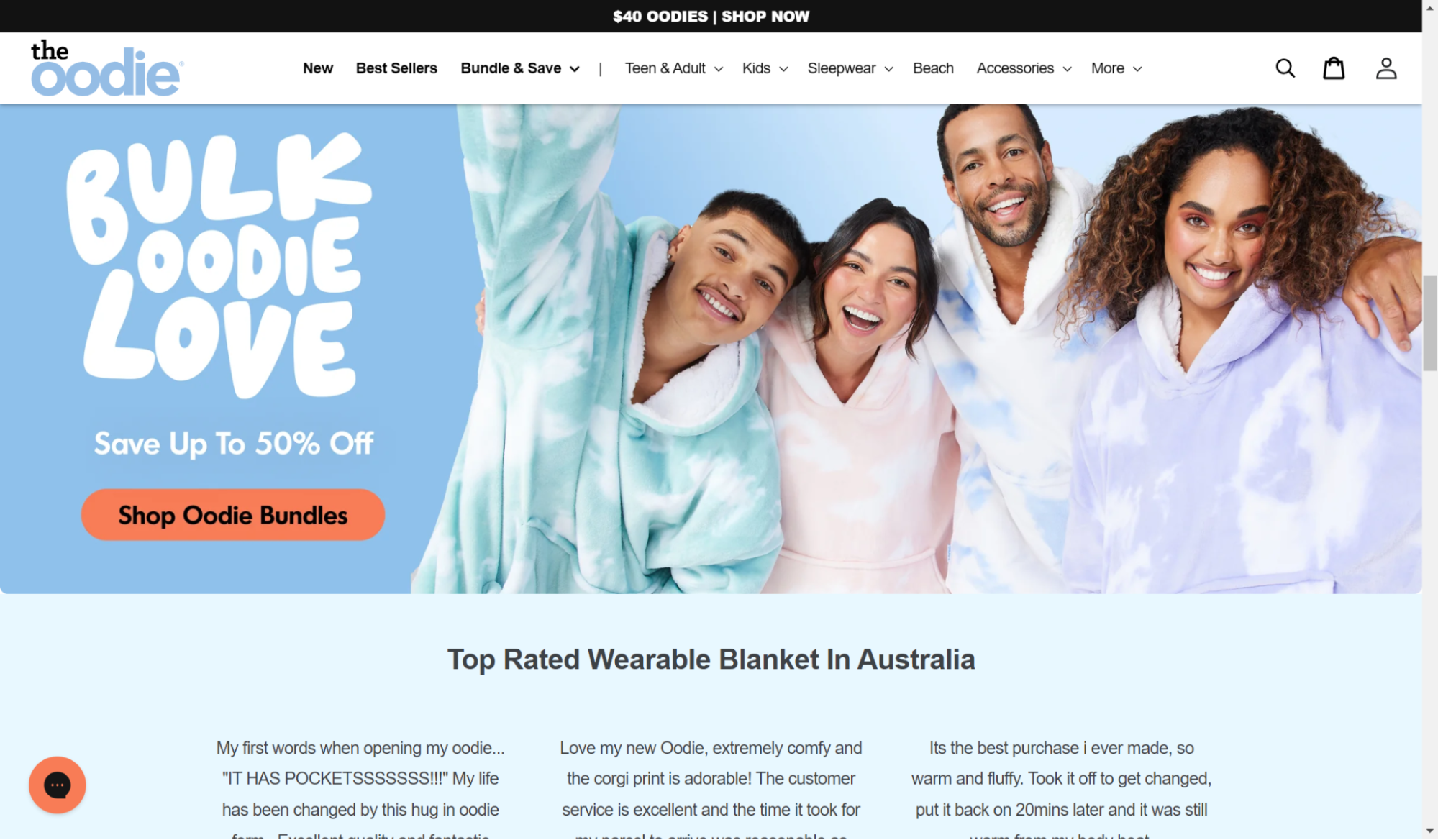 When it comes to colors, opt for a harmonious palette that mirrors your brand's ethos. Stick to a few complementary shades that evoke the right emotions. Canva has a free color palette generator that can help you get a workable tonal scheme down.
When it comes to colors, opt for a harmonious palette that mirrors your brand's ethos. Stick to a few complementary shades that evoke the right emotions. Canva has a free color palette generator that can help you get a workable tonal scheme down.
Fonts are also crucial, as they convey personality. Select a clean, readable font for your main text, and a unique one secondary font for accents or logos.
Your logo, the face of your brand, should be clean, simple, and memorable. It's the visual symbol that represents your business at a glance. Shopify has a free logo generator called Hatchful to help you create a basic workable design.
Consistency is key, whether it's in product photos or social media graphics. Maintain a cohesive style for instant brand recognition. Don't forget the power of storytelling. Share the journey behind your products or services; every brand has a story.
And remember, refinement is part of the process. The most important thing at this stage is to create a minimum viable brand. Later you can test different elements to see what resonates best with your audience.
4 Shopify Tips for Optimizing Your Store
With a product to sell, an audience to sell to and a clean looking brand, it’s time to optimize your store for maximum sales. These Shopify tips are important because they’ll amplify your marketing efforts – potentially turning an unprofitable campaign into a profitable one.
Create An Abandoned Cart Sequence
According to Baymard, the average cart abandonment rate in 2023 was a whopping 70.19%. That means that around seven out of every ten shoppers who reach checkout, won’t convert into customers.
So, the first of our CRO Shopify tips is to create abandoned cart emails. This automation will send a series of emails to cart abandoners, and tempt them back to complete their purchase.
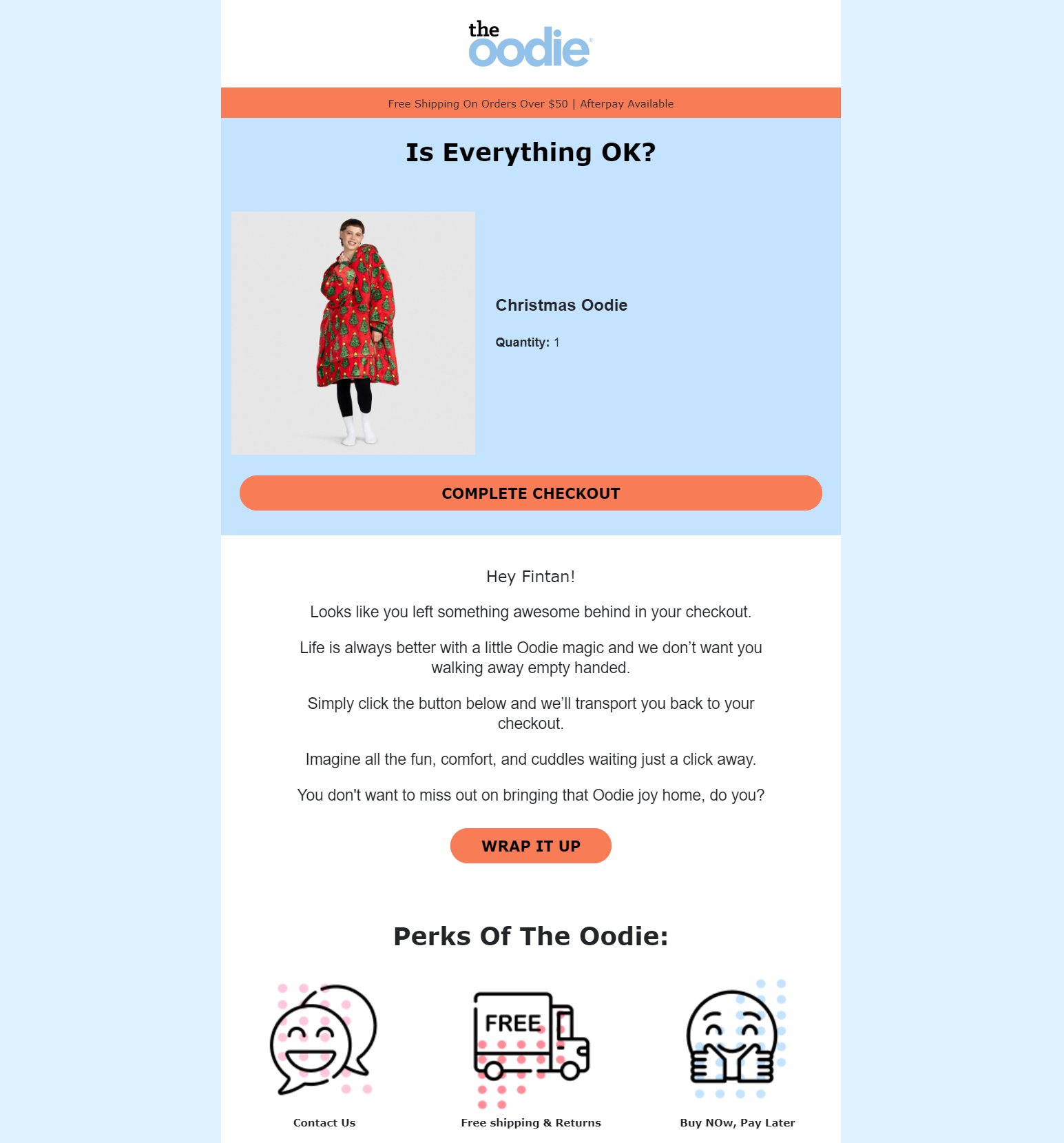 With a tool like Drip, you can sync with your Shopify store, easily design your abandoned cart emails and have them bring back customers on auto-pilot.
With a tool like Drip, you can sync with your Shopify store, easily design your abandoned cart emails and have them bring back customers on auto-pilot.
There’s many ways to configure your abandoned cart sequence. One suggestion is to create a three part series like this:
- 1st reminder: Sent after 30 minutes, this simple email reminds the customer to complete their purchase
- 2nd reminder: Sent after 24 hours, this email can include a time–limited 10% discount on the customer’s cart.
- 3rd reminder: Sent after 48 hours, this email adds urgency, reminding the customer that their 10% discount is about to expire.
In short, abandoned cart emails are a must for every Shopify-based retailer. They’ll capture a portion of sales that you almost had. And once you set them up, they’ll typically bring in more revenue than almost any other email marketing campaign.
Add One--Click Upsells & Thank You Page Offers
With the cost of customer acquisition on the rise, it’s important to ensure you’re extracting the maximum value from every sale.
One of the easiest ways to boost your average order value and profitability is to add one-click upsells and thank you page offers.
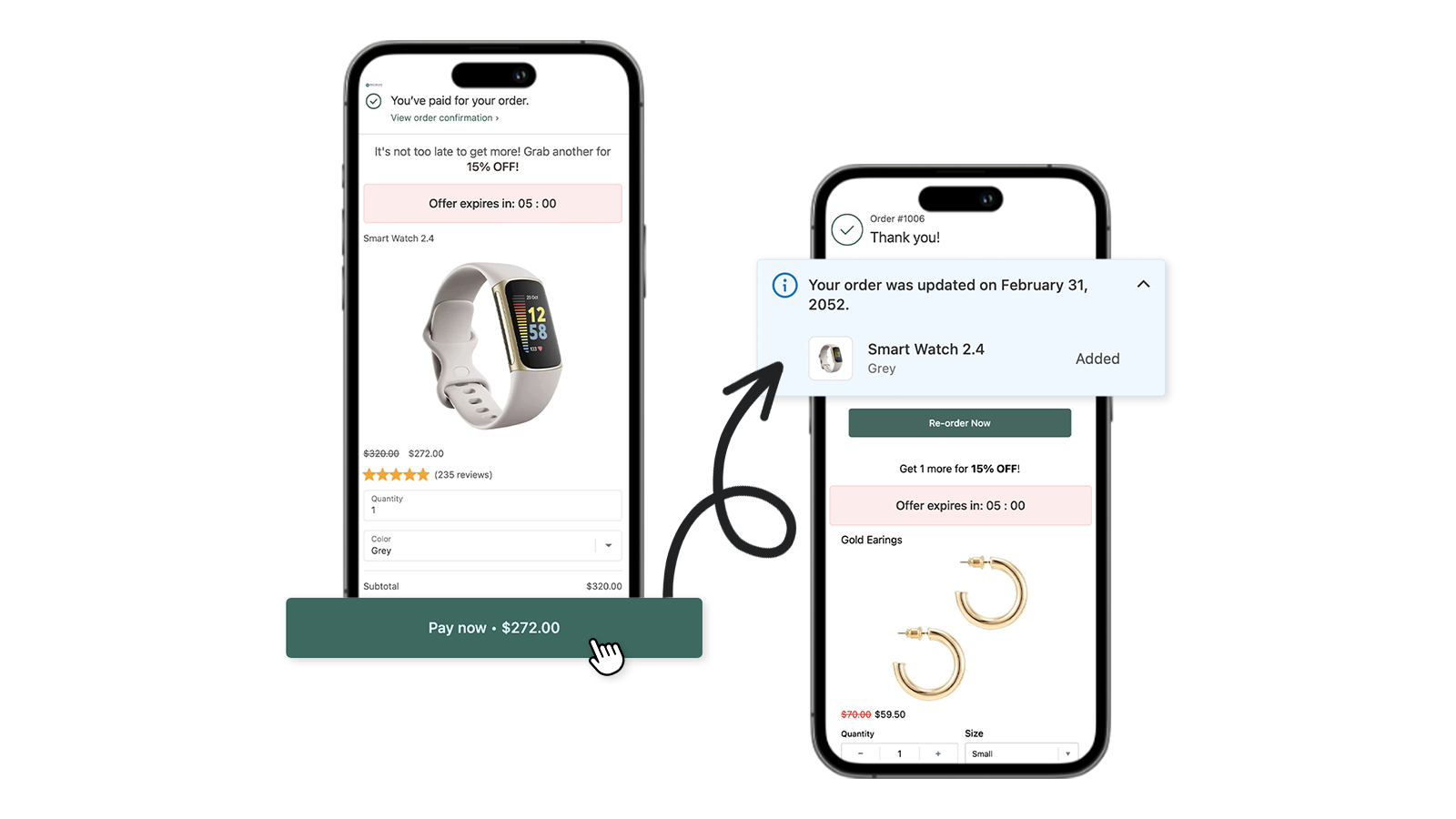 One-click upsells are offers displayed immediately after checkout. So, let’s say a customer buys a new pair of sneakers.
One-click upsells are offers displayed immediately after checkout. So, let’s say a customer buys a new pair of sneakers.
Using one-click upsells, you can immediately cross-sell them a pair of socks – with no need to re-enter their payment details. With well-designed OCU offers, we’ve seen merchants get conversion rates up to 15% – adding serious beef to their bottom line.
Thank you page offers work similarly, but they’re displayed on the order confirmation page. Such offers work so well because your customers are in peak-buying mode when they see them.
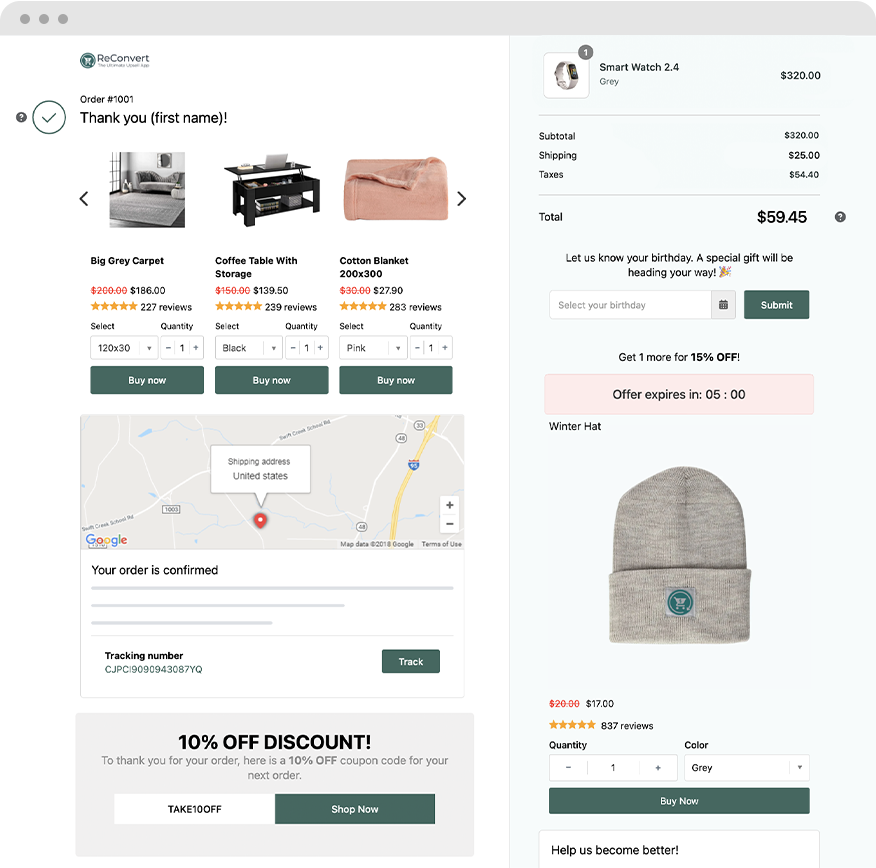 The beauty of these two post-purchase upselling tactics is threefold:
The beauty of these two post-purchase upselling tactics is threefold:
- Frictionless – there’s pretty much no barrier for customers to convert again
- Personalisation – you can design offers based off customer data (e.g cart contents)
- Easy to implement – with ReConvert you can add this functionality to your store in a couple of clicks – no coding required.
Taken together, post-purchase upselling is a must–have strategy that’ll allow you to generate more revenue, for the same marketing spend. In a game of small margins, adding 5–15% to your average order value can be the difference between making profit and losing money.
Build Product Bundles
Product bundling is another effective way to boost your average order value. Bundling is about combining multiple products together in one package.
Typically bundling works best when you offer a discount to tempt customers to spend more and save.
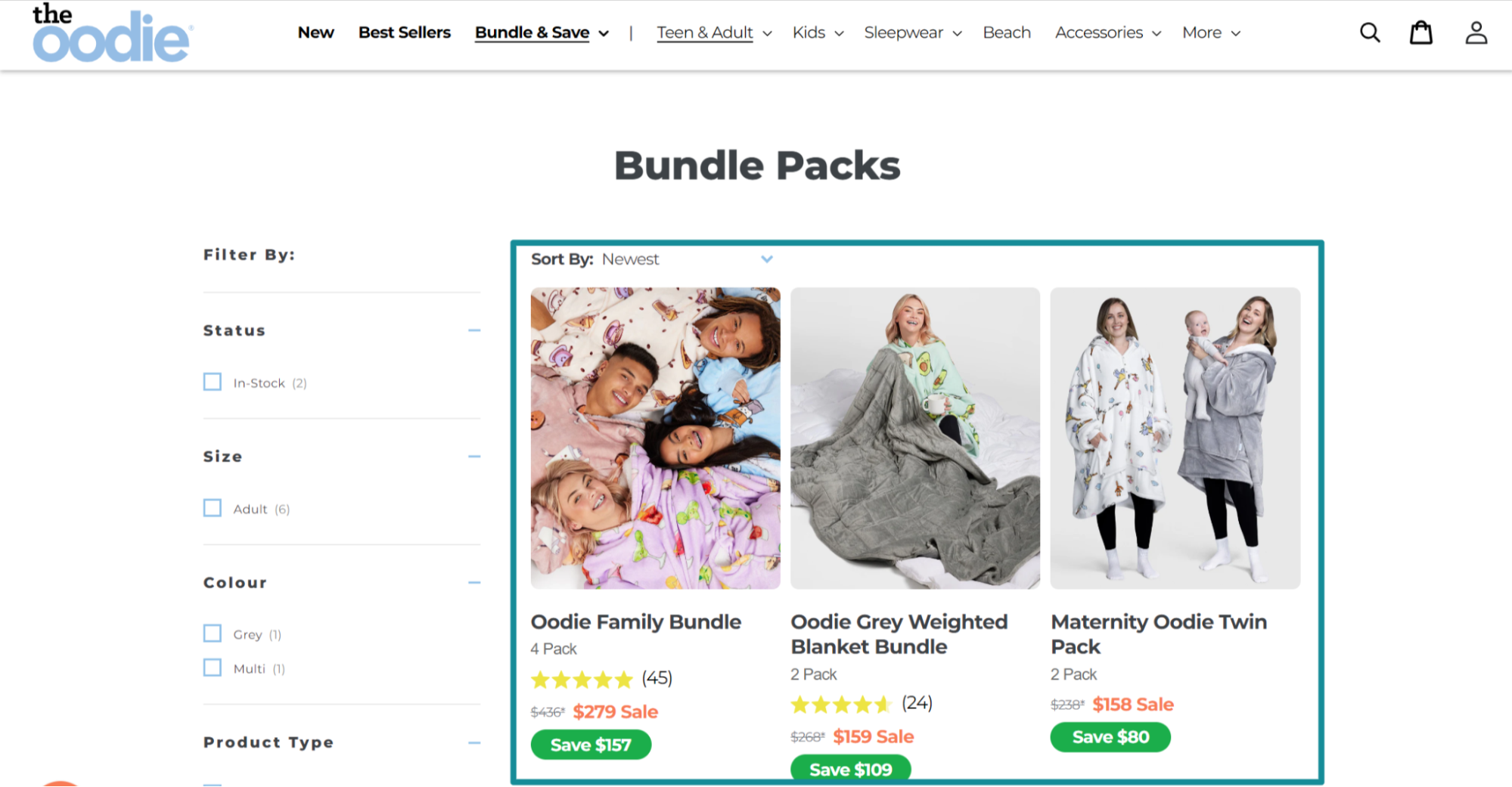 Sticking with the Oodie, you can see how they bundle products together into packs like the ‘family bundle’ and the ‘maternity Oodie twin’. These packages encourage customers to bump up their order value and increase the profits for order.
Sticking with the Oodie, you can see how they bundle products together into packs like the ‘family bundle’ and the ‘maternity Oodie twin’. These packages encourage customers to bump up their order value and increase the profits for order.
Create A Free Shipping Threshold
The most common reason that customers abandon their cart is due to unexpected shipping charges at checkout.
So, offering free shipping is a nice way to instantly boost your conversion rate. Now of course order fulfillment isn’t free – so you’ll need to build these costs into your product pricing.
One clever strategy is to create a free shipping threshold. This means that customers can unlock free shipping when their cart value reaches a certain amount.
As you can see, the Oodie sets this amount at £50. This is smart because a lot of their individual products are priced at £49 and below. So, when customers reach the cart page or checkout, they’re more likely to go back and add more items to the cart.
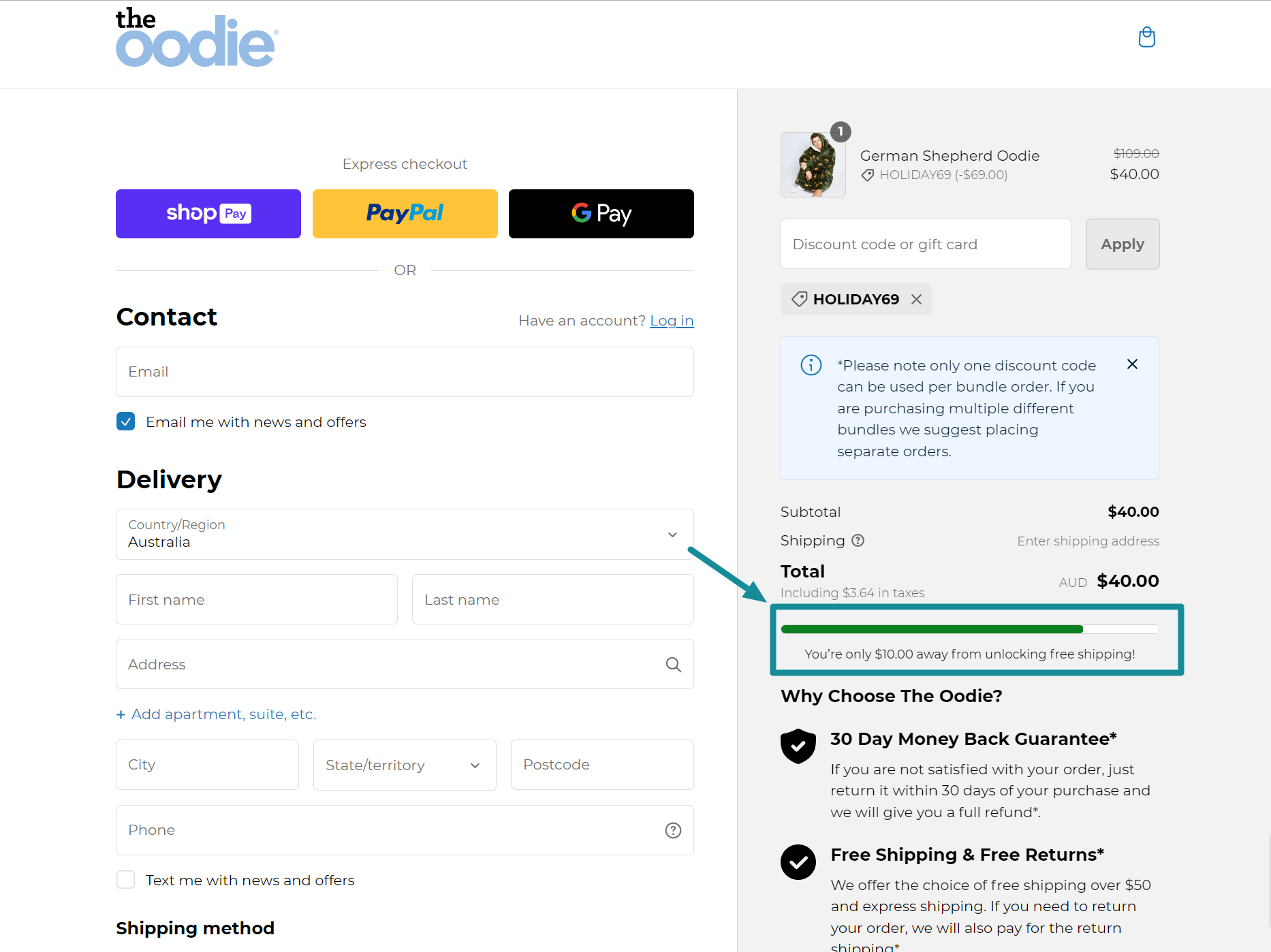 Now, this raises the question – ‘where to set my free shipping threshold?’. The answer to this varies from store to store. Each store has its own fulfillment costs, profit margins etc.
Now, this raises the question – ‘where to set my free shipping threshold?’. The answer to this varies from store to store. Each store has its own fulfillment costs, profit margins etc.
However, a decent rule of thumb is to take your mode order value (the most common order value) and add 20–30% to it. This is typically a nice sweet spot to increase order values, offset shipping costs and increase profitability.
3 Shopify Tips for Marketing Your Store
By now, you’ve identified the products, your audience and built a high converting store. Now it’s time to drive traffic to your store and make sales.
Marketing your Shopify store is an ongoing process. It’s important to start your efforts where you think they’ll yield the most results. It could be search marketing, social media, email marketing or another channel.
A good place to start is to look at the existing competitors in your space. Sign up to their email lists and follow their social media accounts. If they’re an established store, chances are they’ve already figured out the channels and strategies that drive sales.
Team Up with Influencers
Influencer marketing is a great way to generate sales quickly – especially if you’re just starting out.
Influencer marketing is about partnering people (or accounts) with established audiences and asking them to promote your products. Typically this arrangement is in exchange for free gifts, a payment or a revenue-share.
The Oodie uses a team of micro-influencers (audiences below 20k) to promote their products, generate social proof and create user-generated content (UGC) – which they can reuse in their paid and organic social campaigns.
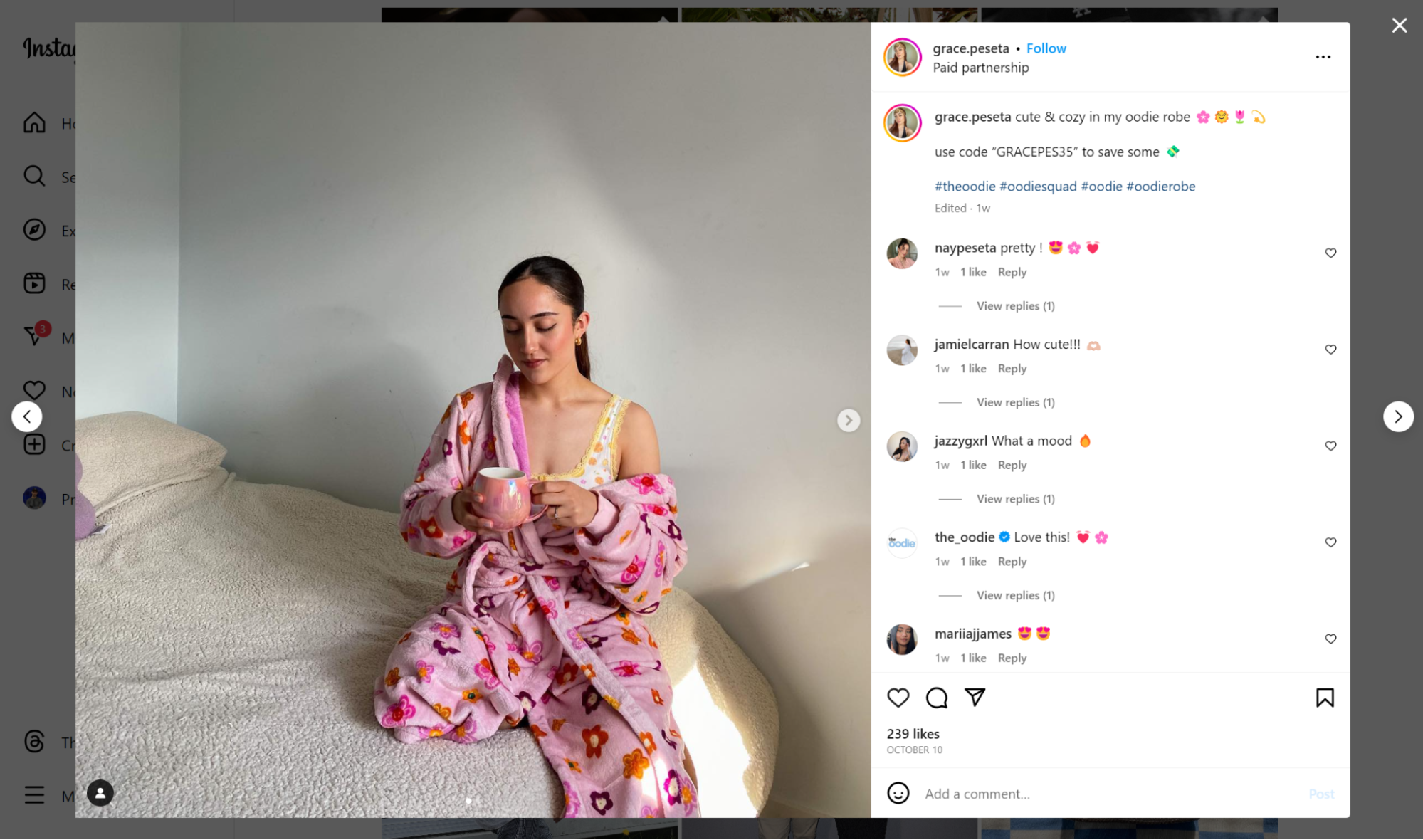 Joining forces with micro-influencers is a good idea for three reasons:
Joining forces with micro-influencers is a good idea for three reasons:
- Affordability – typically way cheaper and easier to engage than large accounts
- Engagement – usually have a more dedicated following
- Long term relationship – easier to work long-term as an advocate of your brand
The key with influencers is to find the right fit for your brand. You should select influencers based on how closely their audience aligns with your ideal buyer.
There’s a selection of solid apps in the Shopify app store to help you build a powerful influencer marketing program – just search for a few and pick the one with the best reviews.
Invest in Organic Search
Search marketing (also known as SEO) is about ranking your store’s pages on Google (and other search engines for specific keywords.
So for example, when a prospect searches for terms related to your brand (e.g. hooded blanket) – your website shows up as a suggested option.
Interestingly, ‘the Oodie’ hasn't invested in search as a channel – but you can see some competitor brands, such as ‘Snuggy’ have done so.
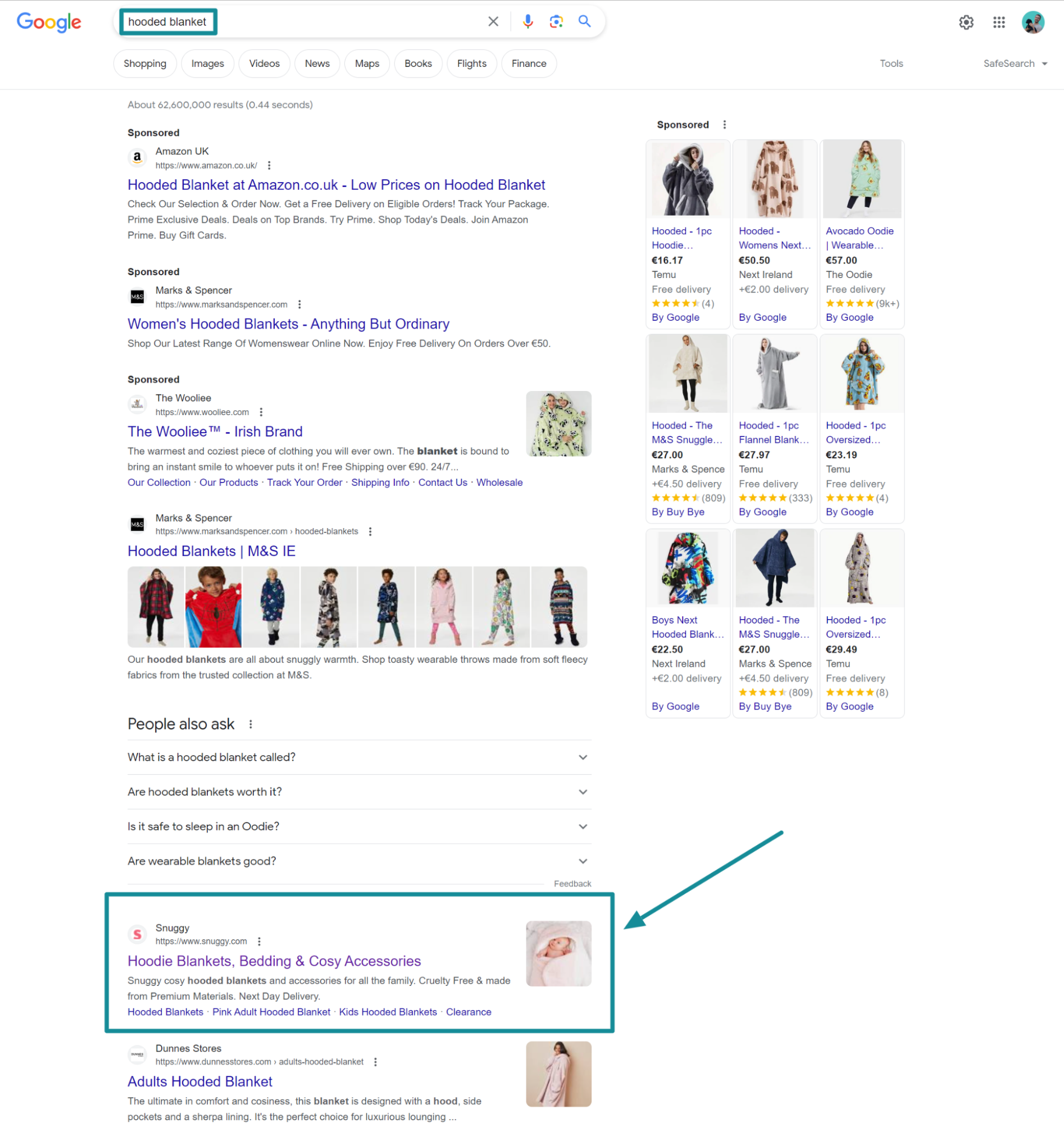 For this term alone, Snuggy gets about 5.5k website visits for free. If we assume their conversion rate is 2% and their average order value is $75 we can estimate that they’re generating $8,250/mo in sales thanks to this search ranking.
For this term alone, Snuggy gets about 5.5k website visits for free. If we assume their conversion rate is 2% and their average order value is $75 we can estimate that they’re generating $8,250/mo in sales thanks to this search ranking.
Now, SEO is a pretty big topic, so any quick advice we could give in this post won't be particularly insightful. So, we’d suggest checking out some of the following resources to learn more:
- Shopify SEO: A Guide to Generating Store Traffic (2023)
- Master E–commerce SEO in 2023: Beginner’s Guide
- 8 of the Best Shopify Blog Examples [Copy Their Strategy]
Run Paid Advertising Campaigns
Paid digital advertising is the go–to channel for many ecommerce brands. And that’s because you can generate results and scale very quickly via Facebook ads, Tiktok ads and Google PPC campaigns.
For example, the Oodie runs ads across all major social platforms. If you’re starting out, you can also look to established brands for inspiration. Using resources like Facebook’s ad library and the Tiktok ads library, you can look at winning ads and model yours accordingly.
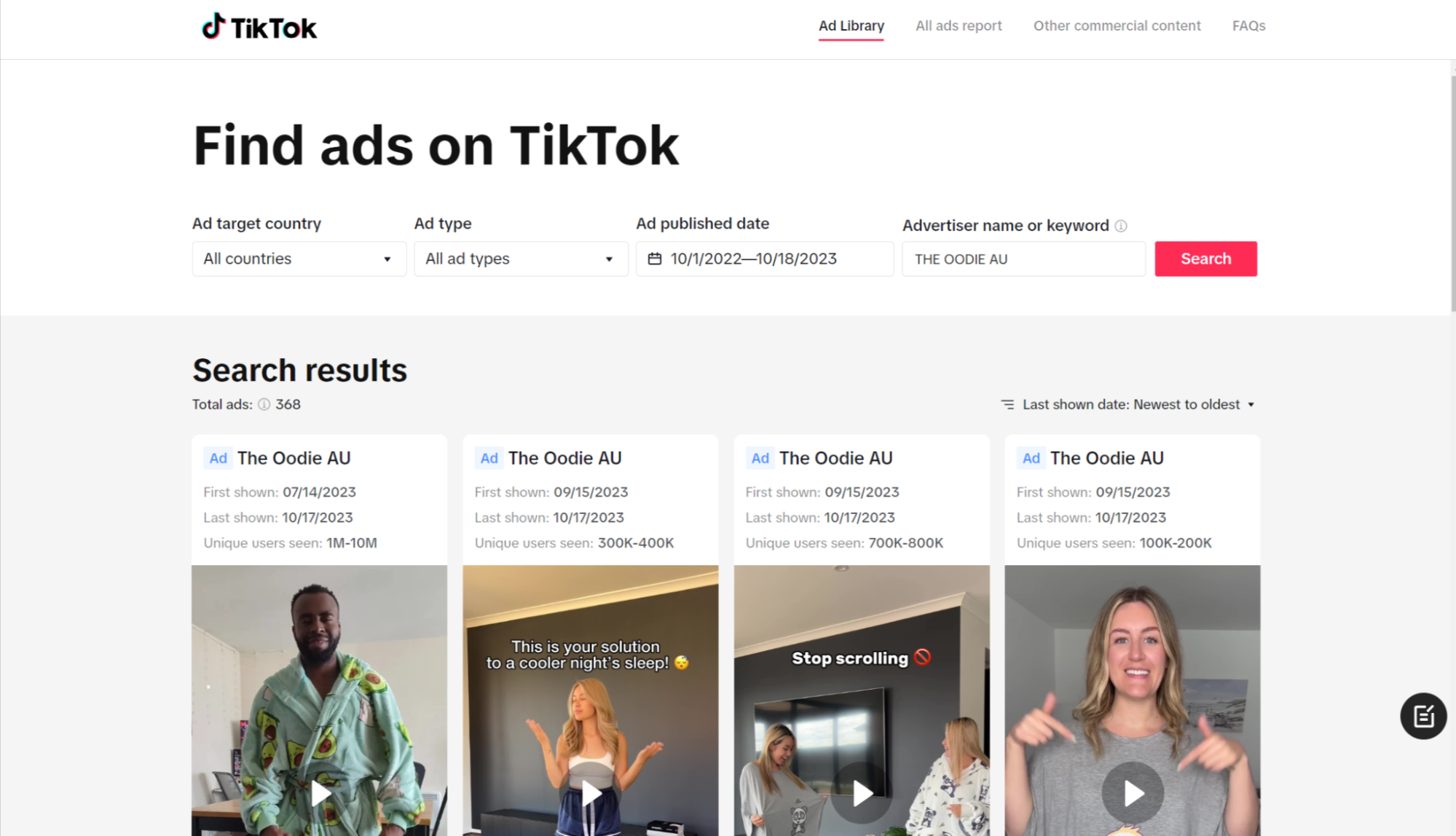 Now, similar to SEO, there’s a lot that goes into running successful paid advertising campaigns. So, specific advice we can offer here is limited in scope. However, if you want to learn more about paid advertising online, here’s two resources that’ll help:
Now, similar to SEO, there’s a lot that goes into running successful paid advertising campaigns. So, specific advice we can offer here is limited in scope. However, if you want to learn more about paid advertising online, here’s two resources that’ll help:
- Meta Blueprint – Facebook’s free and comprehensive course to introduce you to advertising on their platform
- Google Skillshop – A robust introduction to running ads on Google’s network
Use These Shopify Tips Today!
These actionable Shopify tips provide a comprehensive roadmap for building, launching, and scaling a successful ecommerce business.
The fundamental principles of finding a product with demand and reaching the right audience form the cornerstone of this strategy. Rather than reinventing the wheel, identifying market trends and meeting existing demands proves to be a more reliable approach.
Once you’ve established a product-market fit, set up your store. Choose the right Shopify plan, selecting an effective domain name, and customize your store's theme to create a compelling online presence.
Next, optimize your store for maximum sales – implement strategies like abandoned cart sequences, one-click upsells, and product bundling to significantly increase your average order value. Additionally, offering a free shipping threshold helps reduce cart abandonment rates and enhance the customer experience.
Finally, marketing your store is an ongoing effort. Collaborating with influencers, investing in organic search through SEO, and running paid advertising campaigns are powerful methods to drive traffic and boost sales.
By leveraging these Shopify tips, you’ll navigate the competitive ecommerce landscape with confidence and increase your chances of building a profitable business.
Want to make scaling and marketing your Shopify store even easier? Use marketing automation made specifically for Shopify! Drip offers user-friendly automation workflows that make setting up sophisticated marketing campaigns easy. And the best part? You can try it free for 14 days!


